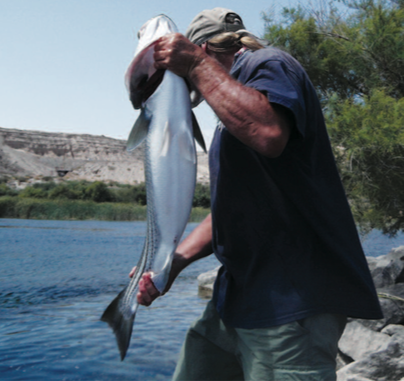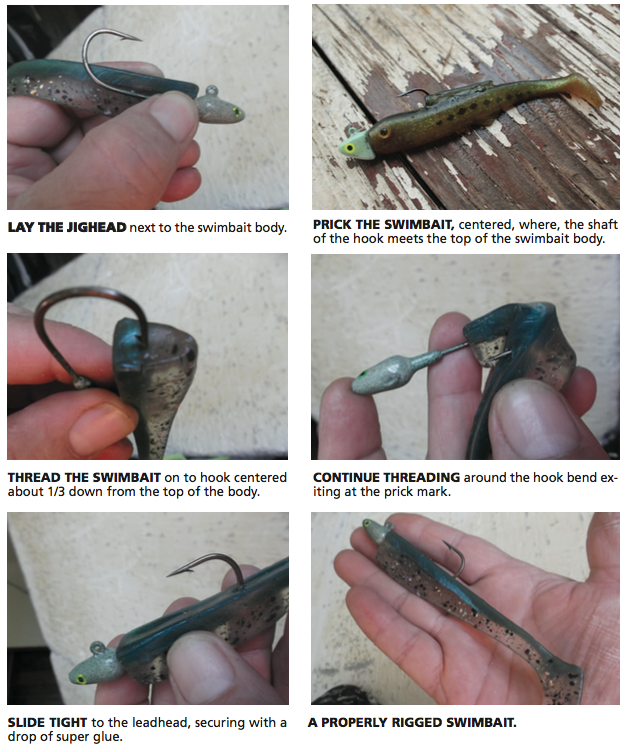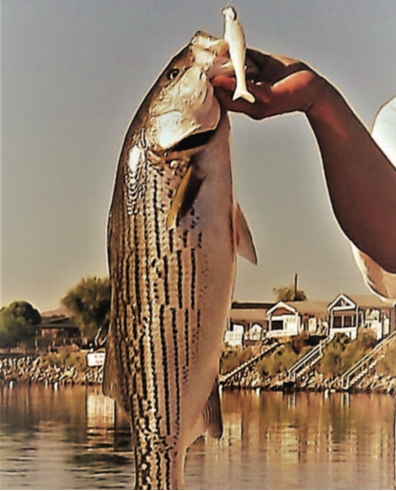BY GUNDY GUNDERSON
The swimbait is one of the most versatile lures in fishing. It has its roots in saltwater fishing but has crossed over nicely into freshwater. Anglers have found success when targeting largemouth bass, smallmouth bass, walleye and muskie. But the one fish that will take the realistic swimming plastic in almost all situations is the striped bass, and it has become one of the most effective striper lures out there.
It comes in many sizes, patterns and profiles, mimicking a wide variety of striped bass forage. It can be fished in many different ways. It can be fished deep or shallow or in the middle of the water column. It can be trolled, cast or fished with an A-rig. When you pursue a fish that can be found in so many places in so many freshwater habitats, a versatile bait like a swimbait is an important lure to master.
Leadheads
There are several leadhead designs that are effective when fishing swimbaits. Many high-end swimbaits have the leadhead built in. Triangle heads transition to the plastic swimbait well and probably evoke the best profile when rigged. Bullet heads or dartheads are also effective, especially when making long casts or casting in the wind. The more compact the leadhead, the better overall casting performance.
Bass fisherman like to use weighted wide-gap hooks for swimbaits. They work well when making short casts around cover. But when pursuing striped bass, long, accurate casts are a prerequisite and the leadhead design can’t be matched in distance and accuracy by a weighted hook.

Because of the potential size and strength of a striped bass, be sure to have a good quality hook on the leadhead, one designed for saltwater fish. Mid to large hook sizes are preferred — always and regularly, check your hook point for sharpness. Due to the flashing nature of a striped bass strike, having a sharp hook is crucial. Short bites are common with this species and a sharp hook will reduce the amount of misses. Check the hook points regularly as it is easy to to blunt one, especially when fishing in shallow water with rock or wood.
As far as leadhead colors, I usually use painted leadheads that match the swimbait pattern. A red and white pattern is a striped bass favorite, so be sure to have a red leadhead to match with an all-white swimbait.
Swimbait bodies
Swimbaits have crossed over into freshwater in recent years and it has fueled an explosion in swimbait designs and patterns. Most function the same way. A tail fob generates a realistic swimming action. The most important considerations are: the profile of the bait, the size of the bait and the color or pattern of the bait. These choices are made based on replicating the dominant or preferred forage on that particular body of water. Here are some basic striped bass forage fish, patterns that you should have in your tackle box.
Threadfin shad
This is one of the top forage items on western lakes and waterways. White and silver colors with a black dot on the body. Small fobbed swimbaits tend to mimic the swim of a shad most accurately. Baits 3 to 4 inches replicate the size — ideal for an A-rig or umbrella rig.
Trout
Another favorite striped bass meal, especially during winter trout plants. Patterns vary with small subtleties in color or brightness. Many trout swim-baits have built-in leadheads, and bait sizes vary widely, ranging from 5 inches to 14 inches. It is one of the better striped bass patterns for trophy linesides. Be sure to match the tackle and line-class to the size of bait.
Gizzard shad
This pattern is up and coming on the Colorado River waterway. The baitfish — which can range from a half-pound to 4 pounds — has become prolific in the river system and lakes Mohave and Havasu. Swimbait sizes can vary from 6 inches to 12 inches, and most lures are grey, white, bronze and silver patterned. More and more gizzard shad pattern swimbaits are becoming available. Gizzard shad baits have similar tackle requirements as trout pattern swimbaits.
Baby striped bass
Another good pattern for jailbirds, especially in the summer and fall months when yearling fish range from 4 to 8 inches and feed in shallow coves. Most of these baits have a silver barred body with white belly. Try to mimic prevailing bait size. In the larger sizes, it is yet another pattern suited for targeting larger fish.
Bluegill/ redear
A lesser used pattern for striped bass, but these can be particularly effective in the spring when the panfish are schooled up and spawning. Fish panfish imitations along grass beds and back bay openings, and key on purple/ green and pumpkin colors. Swimbait sizes ranging from 4 to 6 inches are ideal.
Other effective patterns
There are other patterns that should be in your box. They don’t necessarily mimic a particular forage fish but they are time proven color combos that get bit by striped bass.
Red and white
A striped bass classic, which is usually achieved with red leadhead and an all-white swimbait. It’s a good starting color when unsure of the current local forage.
Orange and black
Always a very strong striper pattern. The color may mimic a crawdad, a more common forage item on western waterways.
Black, or purple and black
Good colors in low light, overcast or when night fishing. Dark pattern baits cast the best silhouettes in situations where the sky is darkened.
Chartreuse
A good color pattern to turn to when the water is green and the sun is bright.
Attaching the leadhead
This is an important part of the lure presentation. If it isn’t done correctly, the lure will not swim straight and will not get bit well. I do it this way: lay the leadhead next to the bait exactly how it would be rigged and note where the hook meets the top of the swimbait. Take the point of the leadhead hook and prick the top of the bait, centered at that meeting point. Begin sliding the swimbait body on to the hook, centered at about a third down from the top. String it on, sliding around the hook bend and exiting at the back where the prick mark was made. Here I like to put a drop of super glue at the back of the leadhead to keep the plastic secure to the leadhead — it will make your plastic last longer, especially after catching a few fish. Without glue — especially after a few fish — the plastic often loosens and slides down the shaft or tears.
Lure modifications
There are things you can do to the swimbait which can enhance its effectiveness – little tweaks that in a specific situation may get you a few extra bites or may increase their effectiveness. As a general rule, I usually start without, just throwing the swimbait pattern. But if I’m not getting bit by the fish I’m seeing or I see lots of followers (but no takers), then I will go to adding some sound, color changes and scent.
Worm rattle
This is a little trick I learned fishing swimbaits in the Salton Sea for orangemouth corvina. In waters with lower visibility, I like sliding a worm rattle in the tail fob. The rattle adds a sonic attraction that can help stripers zero in on a bait in lower visibility conditions. The thin, slender, models with a pointed tip slide easily into the tail. As the bait swims the tail undulates, creating the sound and vibration. The rattle can also be inserted into the belly. Stripers hunt by sight, but also by sound and vibration. It is one of those small things that can give you an edge when the bite is different.
Scent
The use of scent is something dictated by the disposition of the striped bass. If the fish are feeding with abandon, there really isn’t a need. But if you are not getting bit or you’re getting followers and seeing bite-shy fish, then it is time to add attractant. Another scenario is when you are fishing larger-size swimbaits and looking for that one big bite. In this case, scenting the big bait can only help you. I’ve used Bang and Hot Sauce for years but there are lots of choices on today’s market. It can often make a difference, especially on those scratchier days.
Snap ring
Once again, a little nuance that can sometimes make a big difference. Most often, I tie strait to the eye of the swimbait. But when I’m scratching for a bite, I’ll attach just a snap to the lure eye, then I’ll tie to the snap. This allows the lure to swing more freely at the attachment point. It increases the action of the bait and can often entice a strike. Make sure you use a size of snap congruous with the size of lure and line class. Also make sure of the quality. There is a lot of crappy, flimsy terminal tackle now on the market today that you’ll want to avoid altogether.
Lure dip
A trick to add a visual attraction to your swimbait is to dip it with a soft plastic dye. This is another nuanced modification that can enhance the attraction of the lure. One brand of dye is Spike-It Dip-n-Glow. It is soft-plastic color dye with a fish attractant, and it comes in several colors. Chartreuse is the color I use the most. The chartreuse stands out especially in green-tinted waters. I like the red when fishing a white swimbait. The hot pink works well on sunny days. I usually just like to dip the tail — the kick of the fob serves to further animate the color.
The beauty of the swimbait is its simple design and verasatility. It is an indispensable lure in the pursuit of striped bass. If you hope to be an accomplished hunter of striped bass, then you must start by mastering one of the most effective tools for catching one: the swimbait.





